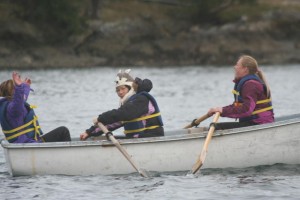I Think We’ve Got The Fear!
After a long week of work we were excited to finally get into town yesterday. We ate a quick lunch, and hopped into the rowboats for a short, and somewhat rambunctious boat ride into Friday Harbor. The Whale Museum was our first, and longest stop. For me the most fascinating part of the museum was the rich cultural connection between the Northwest Coast Native People and the orcas. This subject is of particular interest to me after working at Camp Nor’wester (http://norwester.org/) this past summer. Camp Nor’wester is lucky enough to be home to a native big house, and a Northwest coast Native education program, but until the Whale Museum I didn’t know the native stories of the orcas. After a fascinating hour and half at the museum we decided to mosey around town, and somehow stumbled upon the Sea Shepherd store. For those who don’t know Sea Shepard is an anti-whaling organization founded by Paul Watson. The show Whale Wars follows the organization’s campaigns down in the Southern Sea, where they fight the Japanese whaling fleet. Their methods of stopping the Japanese border on blurred line between eco-terrorism and radical activism, but they do seem to be effective. It just so happened that Peter Hammarstedt, captain of the Sea Shepherd Ship Bob Barker, was doing a meet and greet at the Sea Shepherd store! We got to meet him, and had a really interesting conversation about the role of science in environmental activism (apparently there not much room for it)! This discussion tied in extremely well to our readings and talks in class about sustainability science, and the role science plays in conservation work.
Last week the six of us each presented a case study on sustainability science, and discussed each paper in depth. I presented on a paper titled Rewilding and Biodiversity: Complementary Goals for Continental Conservation by Michael Soule and Reed Noss. This paper discusses the conservation method of rewilding, which aims at creating connectivity between isolated ecosystems. Rewilding is a fairly new technique used by conservation biologists to help preserve the key stone species, which typically are large carnivores, of isolated ecosystems. The concept of rewilding evolved from the theory of Island Biogeography, which was developed by Robert H. MacArthur and Edward O. Wilson in the late 1960s. Island Biogeography is he basic ecological concept that on any isolated environment (originally islands) the ecosystem has a maximum capacity of established species it can hold. The smaller the environment the less species it can sustain, and the higher the extinction rate. Because civilization has built up around many ecosystems, and essentially turned them into ecological “islands†the extinction rate has become much higher in these areas of isolation. Rewilding aims to reconnect these “islands†through wilderness corridors. These wilderness corridors are essentially highways of untouched land through which animals, namely large carnivores, can travel between.
Overall it has been an amazing first week, and I can’t wait to see what the future holds (hopefully whales!). I feel so fortunate to be in such a beautiful place, learning amazing things, with an incredible group of people!
Until next time,
Jamey




 Twitter
Twitter LinkedIn
LinkedIn Facebook
Facebook